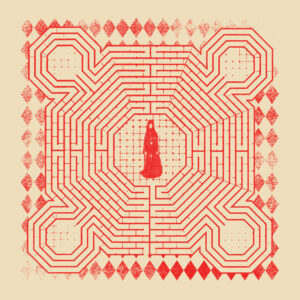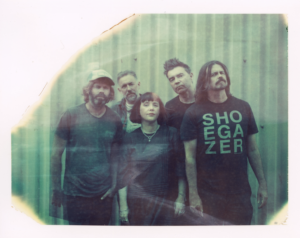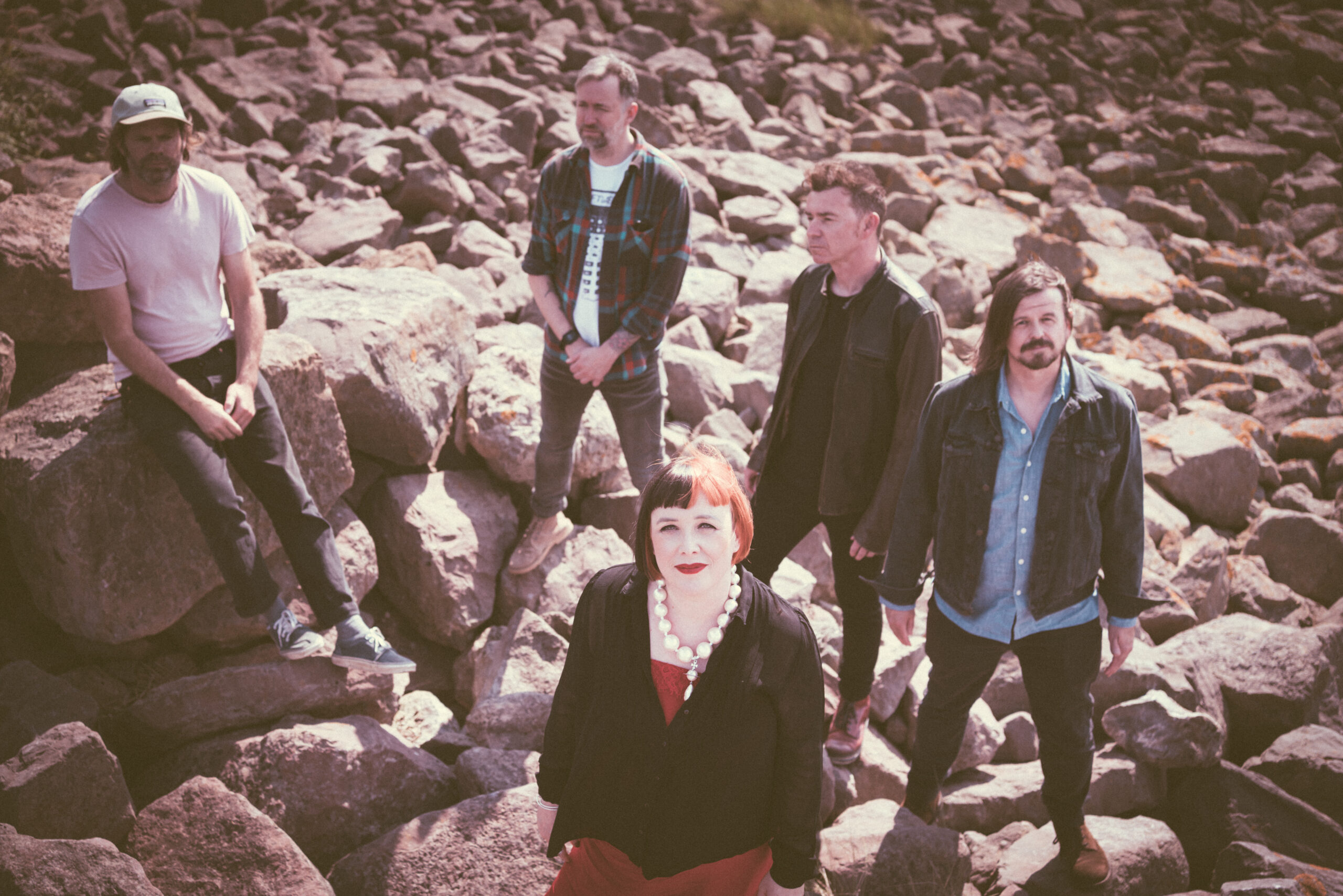Foto-© Parri Thomas
Dass manche junge Rockmusiker in den 80er und 90er Jahren vor lauter Schüchternheit auf ihr Schuhwerk schauten statt ins Publikum, hat einen schönen Subgenre-Begriff abgeworfen: Shoegaze. Letztlich ging es um “sehr schwelgerische Musik, zumeist durch dichte, aber melodische, extrem mehrstimmige Gitarrenwände gekennzeichnet, die mit Hilfe elektronischer Effektgeräte und Synthesizer erzeugt” wurden, wie ein Wikipedia-Eintrag hilfreich zusammenfasst. Dieser nennt als Band-Beispiel an erster Stelle: Slowdive.
Mit Souvlaki (1993) und Pygmalion (1995) hatten das Readinger Quintett bereits mindestens zwei Shoegaze-Meisterwerke auf seinem Konto, ehe es sich nach längerer Trennung 2014 wiedervereinigte. Dem selbstbetitelten, weithin gefeierten Comeback-Werk von 2017 folgt nun mit everything is alive ein erneut starker, den Verdiensten von Slowdive angemessener Longplayer – selbst wenn der Zauber des Neuen nun – 30 beziehungsweise sechs Jahre später – bereits zweifach verflogen ist. In der neusten Ausgabe unseres Podcasts The Space Between the Notes sprechen wir mit Frontmann und Sänger Neil Halstead über das neue Album und vieles mehr – hier zu lesen und hier zu hören!
 I usually like to start these interviews by asking if you could set the scene a little bit for what was going on for the band during the period of working on this album: what was in your mind, what were you driven by creatively?
I usually like to start these interviews by asking if you could set the scene a little bit for what was going on for the band during the period of working on this album: what was in your mind, what were you driven by creatively?
We started talking about doing the record in 2019. We’ve taken a bit of time off, which I think we did our last show at the beginning of 2019 and we were due to have some time off. So I think after about three or four months we started talking about maybe doing some recording. And I’d been working on some electronic music for the last few years. So I thought it might be fun to just sort of try and see if I could use any of that stuff for Slowdive. I sent a bunch of stuff through to everyone. And, you know, we ended up sort of picking a few ideas to work on and that was sort of how it started really probably towards the latter half of 2019. We took some recording time, which was then in 2020, which we had to cancel because of COVID and all that sort of stuff. So that kind of stopped us in our tracks pretty quickly. I guess like everyone else. So, you know, everyone had a pretty hard time with COVID. Rachel lost her mum, Simon lost his dad, obviously a pretty full on experience for those guys particularly. But work wise, we were still sort of working on the record. I can’t remember exactly when, but obviously until COVID was sort of out of the way, we couldn’t really get into a studio. Once we got into the studio, we just sort of cracked on with the record and it was quite a long process with everything. And we really found ourselves taking songs in all kinds of different directions. Just to try and figure out what kind of record we wanted to make and what kind of record felt good for us. So it was a bit of a period of just exploring and seeing what was going to work with some of the ideas that we had originally.
Your comeback record, Slowdive, was probably your most explosive and propulsive record. It felt like quite a celebratory record whereas this one is more wispy and interior really until the very end – it’s not necessarily dark, but it’s more inward facing in my listening, and I read that you initially conceived of everything is alive as a minimal techno record, closer in spirit to Pygmalion. And also that it might have been a solo record of yours at one point. What is the process of building songs like these that are so texturally meticulous and so specific about mood? How many different iterations do you go through? How obsessive are you about sounds? Where does it transition to the studio?
I came to the band with these very minimal electronic pieces of music. And the only idea I had was this would be an interesting starting point, I sent like 40 ideas through this very minimal, very electronic. It was all stuff that had been done on some synthesisers and just different things. But it’s not really fair to say that I wanted to make a minimal electronic record. It was a way to start the record because sometimes you just need to start in a different place. If you want to do something a bit different, it’s usually a good idea to just start it in a different way, you know? Everyone’s different. I’m really obsessive about all that stuff. So a lot of this stuff has gone through many, many iterations and it is just about trying lots of different things, I don’t know how everyone else works on their music, but for me it’s always just exploration. I don’t really know what I want. So you try lots of different things until the thing that goes “oh, that’s cool” comes along. Sometimes it’s an accident as much as anything. So it was just a lot of that and it’s a very slow, slow way. There’s a track on the record I remember which was just initially it was completely the structure it has now, but it was literally just played on a kind of a synth that sounded a bit like a piano, but it had a lot of delay and stuff on it. So Nick and Christian and Simon, I don’t think Rachel was there for this one, but they played along to that simple piece of music, then we took that away from the track and you’re sort of left with this hole in the track. So you kind of deconstruct stuff as well. There was a lot of that happening where you’d record a lot of stuff and then just pull it apart again and then perhaps take take a section of it and just work on that section in a different way. Which is actually very similar to the way we worked with Pygmalion, which was more about deconstructing sounds and sort of creating loops and then creating loops on top of those loops. It’s like making a jigsaw rather than going into a studio and just playing something live. You’re sort of taking bits and pieces and putting them together in different ways to see what works, you know?

And what does that look like for you as a process? Do you have a lot of gear in your house or do you have a home studio and a daily process?
I have a studio. I live in Cornwall. I have a studio which is 20 minutes up the coast from my house. It’s on an old airfield and I’ve been there for 20 years. I moved there in 1994 and I sort of finished the studio in 2002, and I’ve been there ever since. So I have all my stuff there. I’ll just go there five days a week and make music. And I usually work 9 to 5. I don’t really do it to release anything. I mean, sometimes I do it to release a record, but I haven’t stopped doing music. And there was a lot of folk songs for a long time. When Slowdive first finished, I was just really interested in finding out how to write songs because we never really did that. I could never even play a Slowdive song on an acoustic guitar because we always used weird tunings, so you never really knew what the chords were. I literally spent a few years just learning how to play acoustic guitar and how to play conventional chords and really kind of going into country music and not necessarily shoegaze.
Can you try to describe the difference in feeling between writing songs in the 90s that were a really novel type of sound that has influenced so many bands since, and writing decades later having lived through the experience of hearing your imprint on pop and “indie” music. I think many people would agree that these two records that you have made over the past decade are as good as if not better than the ones you made in the 90s, but I’m curious, if you’ll indulge me, to reflect on the differences in making music on either side of that 22 year hiatus.

It doesn’t feel like we make the records much different to how we used to make them. You know, I think for us when we were first making the records, when we were kids, we made the records by ourselves, but we were really lucky. After we signed to Creation on the basis of a demo that had four tracks on it, they wanted us to do some more recording, this studio in Abingdon, just because it was close, we went there and we met this guy Chris Halford, and he became a mentor really. He helped us, he had the studio, he was an engineer and he was in this place where he’d been recording a lot of dance music and was a bit disenchanted because he wanted to record bands. We came along and he got excited about recording with us, I think, because we were doing something that he’d never really heard before. We’d make these records with Chris and we’d go there for a week or three or four days and make an E.P.. We’d come in with an idea of a song and just work with it in the studio. Chris kind of mentored me in terms of learning how to use a studio. We didn’t know anything about studios when we first went there. There was the reverb, which was this amazing button that just made everything sound brilliant. Chris would say you can’t just put reverb on everything. I would be like, but it just sounds cool, you know? It’s just not like you’re breaking the rules because it’s such a stupid thing to say putting reverb on everything breaks the rules. But technically it wasn’t really the done thing and we weren’t making records that we expected to hear on the radio, so we didn’t care if you couldn’t hear the vocals or if the drums weren’t super loud as long as the guitars were really loud. As long as you could turn it up really loud and kind of feel surrounded by this music. We wanted to make records like the Cocteau Twins, like Sonic Youth, like My Bloody Valentine, like Dinosaur Jr, these bands that were making really interesting music with guitars. Chris really helped us do that. The label never came to the studio. We’d kind of just go there, we’d make something, we’d give it to them, and they put it out. That was kind of how it worked, up to a point anyway. Chris later went on to find this band called On A Friday, who eventually changed their name to Radiohead, and he still manages them. So we were making Pygmalion when Chris first started managing Radiohead, I guess when Pablo Honey came out. They were doing demos and working out versions of the songs for Pablo Honey in Chris’s studio while we were doing Pygmalion. It’s just sort of weird to think about now.
Are you listening to and influenced by a lot of contemporary music? What are your biggest influences at the moment?
I think just as a songwriter, you’re kind of influenced by everything. I find it really difficult to listen to much music when I’m working on a record. I guess everyone’s different, but I find it really distracting. So I when I’m not making a solo record, I’ll be consuming more music.
Are you still driven to explore new sounds? Do you still buy new tech and pedals and synths or do you have your faves and stick to them?
I went through a phase of just buying a lot of stuff and I kind of I felt like I was a total modular junkie for a while. I think a lot of people go down that rabbit hole. I’m over it now a little bit. I spent so much money and it is a rabbit hole because these things, they’re brilliant, but because there’s no presets, you might spend a whole night just creating something really wonderful using a bunch of different modules, and then you’ll come back the next day and you can’t really recreate it. So it’s kind of one of those things where it’s a lot of editing, making that kind of music. I’m not really like super techy, but I do go into stuff like compressors and pedals and that sort of stuff. But I’m not really someone who knows a lot about microphones and that kind of stuff.
How do you know when one of these songs is finished?
I think as a band if all five of us are into something, then we know we’re kind of on to something and will pursue it, but sometimes it takes a while to get to that point. I think with this record, the rest of the band definitely had a meeting and were like, we need to find a mix engineer because otherwise Neil is just going to fiddle with this for the next ten years. Which was quite a helpful thing. I think there was a point where I was really struggling with finishing the record. So when we got Sean Everett involved, and I went over to L.A. and sat in while he mixed it, he did a really good job, I think.

I’d like to ask you about the slab, which is my favourite song on the record, and is perhaps the only moment of heightened drama on everything is alive. One thing I love about it is that it sounds better if you listen to the full album leading up to it rather than as a stand-alone track, and that’s somewhat rare nowadays, I think the importance of sequencing is not as acknowledged as perhaps it has been in the past, and I love when the tracks on either side of a song elevate the listening experience. Can you talk a little bit about how much you think about sequencing, and also the process of writing “the slab” and what that song is about for you?
Well, in terms of sequencing, I think we always think about the thing as an album. I guess we’re probably old fashioned in that respect. We grew up listening to vinyl and that whole experience of, you know, you get your record and you listen to it. You get the A-side, you get the B-side. And it is it’s the whole thing, you know. I certainly thought “shanty” is probably going to be the first track. And once we started working on the slab, it always felt like the slab was going to be the last track. And so we had these bookends to the record quite early on. the slab sort of came about literally just from this very heavy kind of keyboard sound. You create these polyphonic chords by just stacking up these oscillators so it was playing fifths and thirds and also these low octaves and it’s just creating a slab of sound. Were trying to get it to sound pretty heavy, dense and have some sort of weight to it.
Apart from music, what is the most fun thing?
I started surfing in 1991, the first time we went to America, it was at the end of the tour. Me and Simon kind of got kidnapped by these kids from Huntington Beach after the show, and we ended up staying in Huntington for a few days and they took us out surfing and I kind of got the bug. Yeah, I really got the bug at that point. I came back and I was living in London at the time and I’d be like scooting off to Cornwall every other weekend to surf and that was before you could kind of have like surf forecasts online and all that sort of stuff. So eventually I got a couple of mates down in Newquay and I’d ring them up and ask them how the surf was looking. I’d get in my old red Fiesta and drive down at 2 in the morning so I could get there at 6 in the morning to get surf. I became obsessed with it for a while. It definitely changes your life a little bit.
Slowdive Tour:
18.01.24 Köln, Live Music Hall
20.01.24 Hamburg, Große Freiheit 36
25.01.24 Berlin, Columbiahalle
29.01.24 München, Muffathalle










